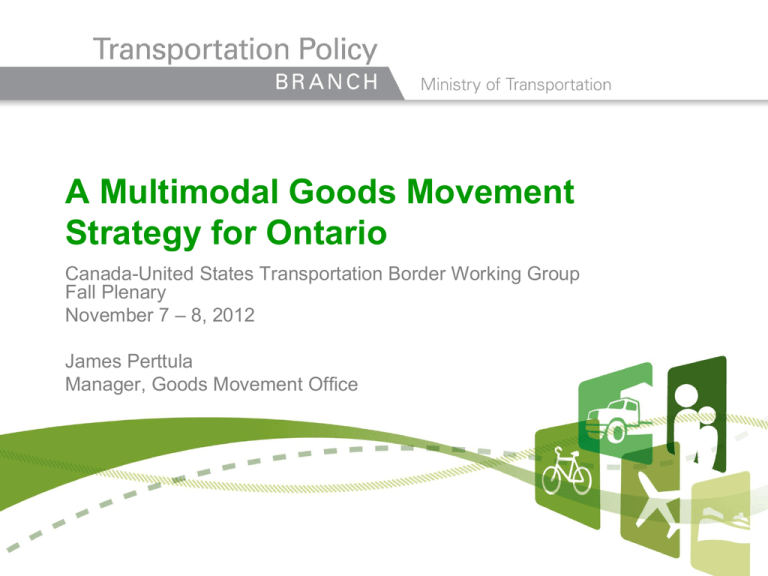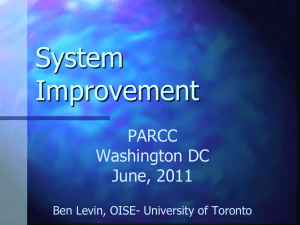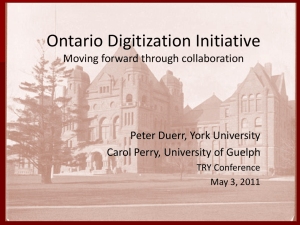A Multimodal Goods Movement Strategy for Ontario
advertisement

A Multimodal Goods Movement Strategy for Ontario Canada-United States Transportation Border Working Group Fall Plenary November 7 – 8, 2012 James Perttula Manager, Goods Movement Office Overview Transportation Policy Branch Goods Movement and Trade in Ontario Multimodal Goods Movement Strategy for Ontario Partnership and Cooperation Moving Forward 2 Goods Movement and Trade in Ontario Transportation Policy Branch 3 Ontario is a goods movement and trade powerhouse. Its strategic advantages include access to a large population base, strong connections to international markets, and the presence of four well-developed modes – road, air, rail and marine – operating individually and in a multimodal manner to serve business demands. Ontario generates over 50% of Canada-U.S. trade, valued at $284 billion in 2011. Ontario’s economy is closely integrated with Great Lakes states. The top three Canada-U.S. border crossings are located in Ontario. This represents 57% of the total trucks crossing the border. Key state trading partners for Ontario include Michigan, Ohio, New York, California and Illinois. Trade is Important for the Economy of all Regions Transportation Policy Branch Multimodal Goods Movement Strategy for Ontario Transportation Policy Branch 5 Over the past several years, the Ministry of Transportation (MTO) has undertaken significant work on goods movement, on its own and in partnership with the federal and Quebec governments The culmination of that work will be the release of the Multimodal Goods Movement Strategy for Ontario. Ontario’s long-term vision for goods movement is to capitalize on the strengths of the transportation system to drive economic competitiveness and become a world class connection for global supply chains. The Ontario Multimodal Goods Movement Strategy works toward this vision by providing a fiscally responsible, long-term plan to drive economic competitiveness through a strong multimodal transportation system. Public consultations on a draft of the strategy were just completed, with the intent of releasing a final strategy and associated action plan in early 2013. Vision & Objectives Capitalize on the strengths of Ontario’s transportation system to drive economic competitiveness and become a world-class connection for global supply chains. System Objectives: Well connected between modes and to domestic and global markets Agile and competitive, providing cost-competitive transportation options to business Reliable and efficient, reducing supply chain risk Guiding Principles Shipper Interest Public Interest & Benefit Partnership Evidence-Based Action Strategies Maintain a modern, efficient and reliable multimodal transportation system. Advance a streamlined and competitive regulatory environment. Foster partnerships for a system-wide approach to transportation planning. Improve integration of sustainable practices into goods movement. Rolling 3-Year Action Plan Specific action items to support areas of focus. Promote our strengths and successes to maximize the value of our investments. Partnership and Cooperation Transportation Policy Branch 7 The strategy recognizes the vital role that transportation plays in the North American economy, and provides a basis to forge strategic partnerships with municipal, federal and neighbouring governments to advance common goods movement interests. Understanding the unique role that each government plays in the transportation system allows for improved coordination of initiatives, and stronger partnerships. Working together results in more targeted and streamlined plans for the benefit of the system as whole. Ontario has been involved in a number of initiatives involving coordination between provincial, federal and state governments, which have shown the benefits of partnership. Canada-U.S. Beyond the Borders Partnership Ontario-Quebec Trade and Economic Partnership Agreement Bi-national Strategy for the Niagara Frontier Windsor-Essex Parkway/Detroit River International Crossing Partnership and Cooperation Ontario’s transportation system is only one part of an integrated North-American and global system, as evidenced by the supply chain example for Lumber, Paper and Furniture. This is just one of many sectors that operate as integrated North American industries. Through consultations on the strategy, stakeholders have highlighted that strong connections between the modes and with neighbouring jurisdictions are essential for the efficient and seamless movement of goods. Transportation Policy Branch 8 Stakeholder Push for Greater Partnership and Cooperation Transportation Policy Branch Stakeholders are pushing for Ontario to pursue strengthened partnerships and cooperation on a number of fronts: ITS corridors More streamlined operations with real-time traffic information. Vehicle Weights and Dimensions Improved harmonization between jurisdictions, including Long Combination Vehicle standards. Ballast Water Uniform regulations to facilitate inter-jurisdictional operations and ensure a level playing field. CNG/LNG Natural Gas Development of natural gas corridors for trucking. Beyond the Borders Push to accelerate progress on this initiative. Moving Forward Transportation Policy Branch The Multimodal Goods Movement Strategy for Ontario is the first step in building the transportation system of the future. It will ensure that our transportation system responds to changing markets and changing business needs as our economy continues to recover and grow over the long term. MTO is excited to look for new opportunities to build partnerships with neighbouring jurisdictions that support a strong transportation system. We are very interested in ideas on how we can work together. 10








